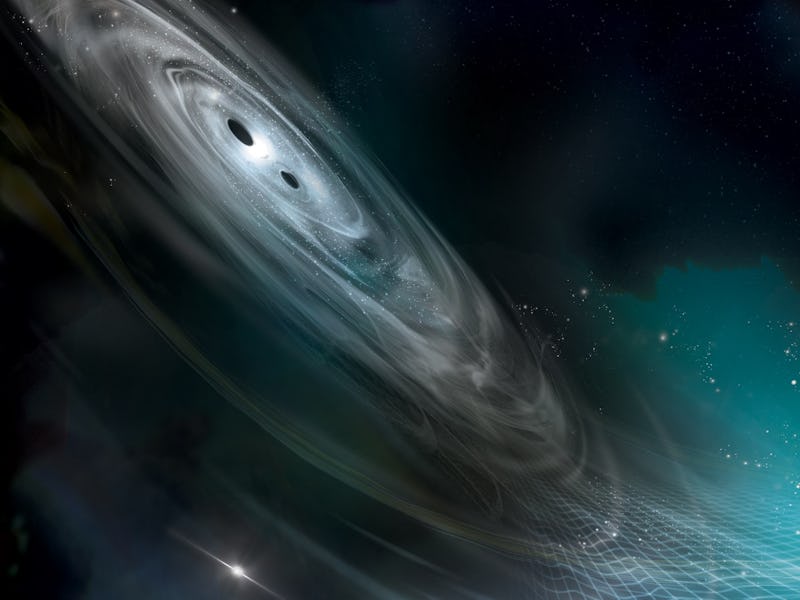Scientists Just Heard the Hum of Giant Black Holes — Here's How They'll Pinpoint the Source
The nanohertz gravitational wave background is officially a thing now, but where do astronomers go from here?

Astronomers just discovered a background “hum” of low-frequency gravitational waves constantly rippling through the universe — but what’s next?
When two galaxies merge, the supermassive black holes at their centers eventually spiral closer together and merge into an even more supermassive black hole. The motion of these cosmic leviathans creates long, low-frequency waves in the fabric of spacetime, called nanohertz gravitational waves. Astronomers just measured these extremely low-frequency gravitational waves for the first time — by turning a whole quadrant of our galaxy into a giant astronomical instrument.
Here’s what happens next.
3. Watching supermassive black holes make waves
Right now, NANOGrav and other international teams have managed to detect the combined effect of what could be hundreds of thousands of merging pairs of supermassive black holes. But within a few years, West Virginia University astronomer Maura McLaughlin said during an announcement on Thursday, they hope to have high enough resolution to follow specific gravitational waves back to the pairs of supermassive black holes that spawned them.
If that happens, astronomers will get to observe the death spiral of two supermassive black holes in every wavelength from infrared to gamma rays – and in the subtle warping of spacetime itself, through gravitational waves. And that, says McLaughlin, could “answer fundamental questions about where they come from, how they evolve, and how they interact with the galaxies that they live in.”
The two supermassive black holes at the center of this galaxy are spiralling close enough together to create ripples in the fabric of spacetime.
2. Mapping the gravitational wave background
Before McLaughlin and her colleagues can watch individual supermassive black hole mergers making waves, however, they’ll need to map the gravitational wave background they’ve just discovered. Other astronomers have already mapped the cosmic microwave background (the faint afterglow of microwave radiation from the formation of the universe) and used its patterns to piece together information about the primordial universe. The NANOGrav team hopes to do something similar with the gravitational wave background.
“Just like we can create maps of the night sky using electromagnetic radiation, we can now create maps of the sky using gravitation waves,” says Northwestern University astrophysicist Luke Kelley. “We expect to be able to detect whether the gravitational wave background is stronger in one part of the sky than another.”
Those patterns will help astrophysicists like Kelly and his colleagues figure out whether all of the gravitational waves rippling through the universe are coming from supermassive black holes about to merge, or whether some are coming from other sources, like events in the very early universe or even “new kinds of fundamental physics” — in other words, physics we don’t even know that we don’t know about yet.
1. Gathering more data
Mapping the gravitational wave background and eventually using nanohertz gravitational waves to study individual pairs of merging supermassive black holes will require a lot more data. Taking a high-resolution picture with a digital camera requires a lot of very small pixels; to get a high-resolution look at gravitational waves, astronomers like the NANOGrav team will need a lot of pulsars and a lot of time.
Just discovering the gravitational wave background took an enormous amount of data; the astronomers observed 68 different pulsars for 15 years to be sure that the tiny fluctuations in the pulsars’ radio beams actually matched the pattern predicted by Einstein's theory of general relativity. NANOGrav astronomers and their colleagues at other pulsar timing arrays around the world are still watching those pulsars. They’re also looking for new ones to add to the array, which will eventually mean they’ll have a more sensitive detector and a higher-resolution view of the universe.
NANOGrav and other pulsar timing array teams in Australia, Europe, China, and India are in the process of combining all the data that each team has collected independently over the last 15 years, fusing it into what McLaughlin calls “an uber-dataset” from what’s called the International Pulsar Timing Array (IPTA).
“In this combined IPTA dataset, we may even detect our first individual supermassive black hole binary source,” says McLaughlin. They expect to publish a new set of papers in two or three years.